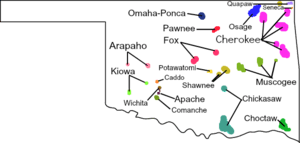Omaha–Ponca language facts for kids
Quick facts for kids Omaha–Ponca |
||||
|---|---|---|---|---|
| Native to | United States | |||
| Region | Nebraska and Oklahoma | |||
| Ethnicity | 525 (365 Omaha, 160 Ponca, 2010 census) | |||
| Native speakers | 85 (2007)e18 | |||
| Language family |
Siouan
|
|||

Map showing the distribution of Oklahoma Indian Languages
|
||||
|
||||
The Omaha–Ponca language is a Siouan language. It is spoken by the Omaha people in Nebraska. It is also spoken by the Ponca people in Oklahoma and Nebraska. The two groups speak slightly different versions of the language. However, the Omaha and Ponca people consider them to be separate languages.
Contents
Efforts to Save the Language
Today, there are very few people who speak Omaha–Ponca fluently. Only about 60 people speak Omaha, and only 12 of them are fluent. All of these fluent speakers are over 70 years old. There are also a few people who speak Ponca well.
Many groups are working to keep the language alive. The University of Nebraska offers classes in the Omaha language. They also have a project called OLCDP. This project provides online materials to help people learn the language.
In 2015, there were only 12 fluent Omaha speakers. Two of these speakers were also qualified teachers. The Tribal Council believes about 150 people have some knowledge of the language. The Umónhon Nation Public School teaches the language to students.
An iPhone app called "Omaha Basic" was created. It was made by the Omaha Nation Public Schools and the Omaha Language Cultural Center. The Osage Nation of Oklahoma is also interested in working with the Omaha and Ponca. They want to use the Omaha–Ponca language to help bring back the Osage language, which is similar. A dictionary of the Ponca language was also published.
Sounds of Omaha–Ponca
Every language has its own unique sounds. The study of these sounds is called phonology. Omaha–Ponca has some sounds that are different from English. For example, it has sounds like "th" that can change the meaning of a word.
Consonant Sounds
Omaha–Ponca has many consonant sounds. Some of these sounds are made with your lips, like 'm' or 'p'. Others are made with your tongue touching your teeth, like 't' or 'd'. There are also sounds made further back in your mouth, like 'k' or 'g'.
One special sound in Omaha–Ponca is sometimes written as l or th. It's a sound that comes from the back of your mouth and your tongue. You can hear it in the word ní btháska. This word means "flat water" and is where the name Platte River comes from. This is also the source of the name Nebraska.
Vowel Sounds
Omaha–Ponca has several vowel sounds. These are sounds like 'a', 'e', 'i', and 'u'. Some words also use an 'o' sound, especially when men speak.
The language also has "nasal vowels." These are vowel sounds where air comes out of your nose, like when you say "mmm." In Omaha and Ponca, some nasal vowel sounds have joined together.
Tone and Word Meaning
Omaha–Ponca is a tonal language. This means that the pitch of your voice when you say a word can change its meaning. For example, if you say a word with a high tone, it might mean one thing. If you say the same word with a slightly lower tone, it could mean something else.
For example:
- wathátʰe can mean "food."
- wáthatʰe can mean "table."
The length of a vowel can also change the meaning of a word. Even if it's not always written, it's important for understanding.
Different Sounds, Different Meanings
In Omaha–Ponca, some sounds that might seem similar in English can actually make words mean completely different things. These are called minimal pairs. Here are some examples:
- p versus pʰ (an 'p' sound with a puff of air):
- pa means "head" or "nose."
- pʰa means "bitter."
- i versus ĩ (a nasal 'i' sound):
- nazhi means "to go out."
- nazhĩ́ means "to stand."
- t versus tʼ (a 't' sound with a quick release):
- tṍde means "the ground."
- t’ṍde means "during future early autumns."
How Words Are Formed
The way words are built in a language is called morphology. Omaha–Ponca adds special endings to its words. These endings tell you more about the word. For example, they can tell you if something is alive or not. They can also tell you if there is one of something or many. And they can tell you if an object is lying down, standing up, or round.
For example, different endings are used for:
- An object that is not alive and lying flat.
- An object that is not alive and standing up.
- An object that is not alive and round.
- A single living thing that is doing an action.
- Many living things, or a single living thing that is moving.
- A single living thing that is standing still.
- A single living thing that is moving.
- Many living things that are moving.
- A single living thing that is sitting.
- Many living things that are sitting.
Sentence Structure
In Omaha–Ponca, sentences are usually put together in a specific order. They follow a subject-object-verb pattern. This means the person or thing doing the action comes first. Then comes the thing the action is done to. Finally, the action itself comes last.
For example, in English we might say "The boy ate the apple" (Subject-Verb-Object). In Omaha–Ponca, it would be more like "The boy the apple ate."
See also
 In Spanish: Idioma omaha para niños
In Spanish: Idioma omaha para niños

